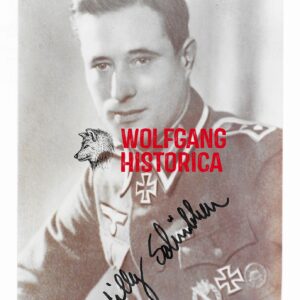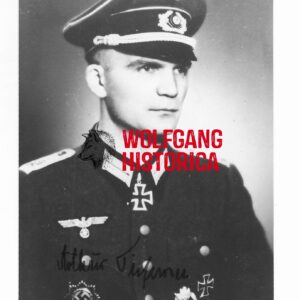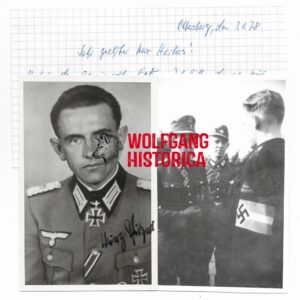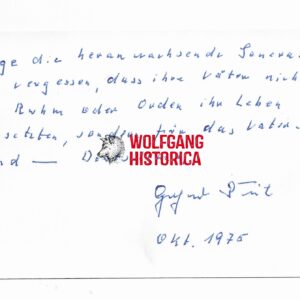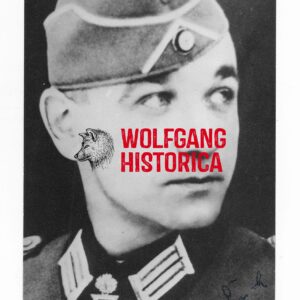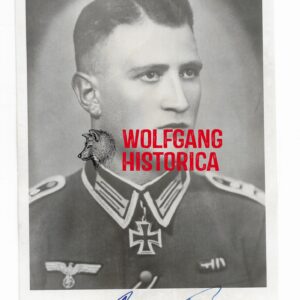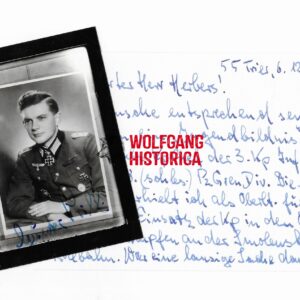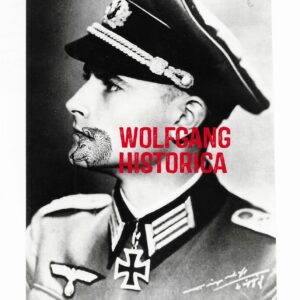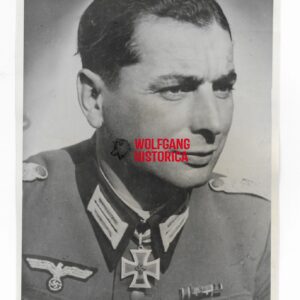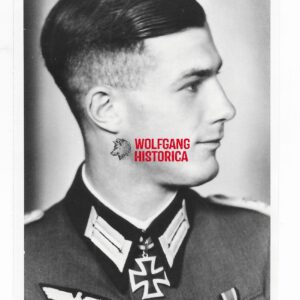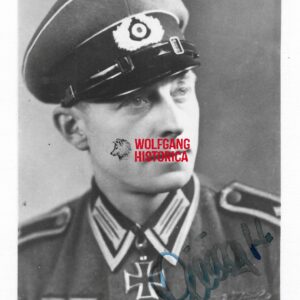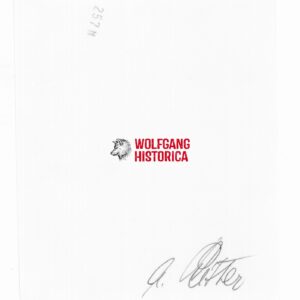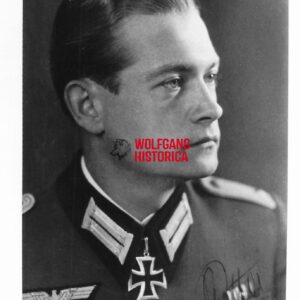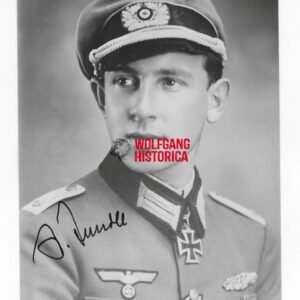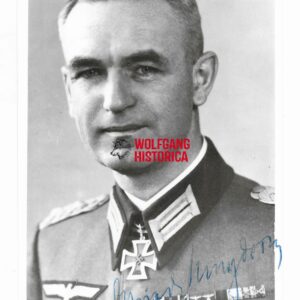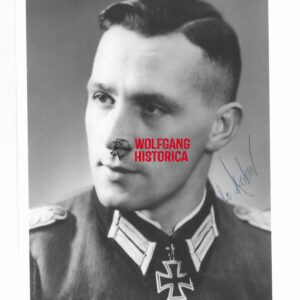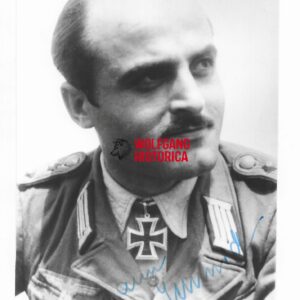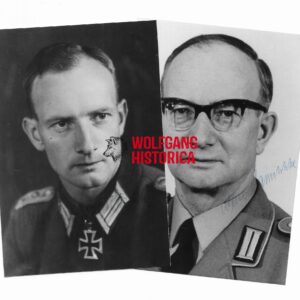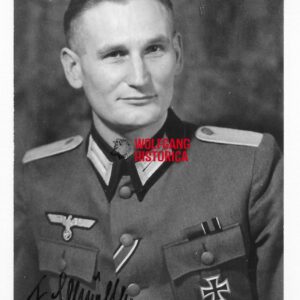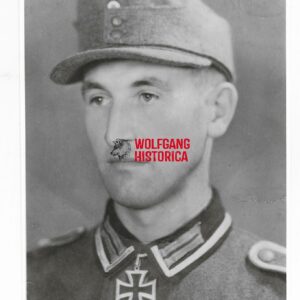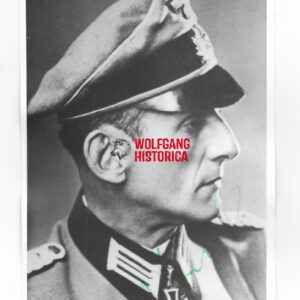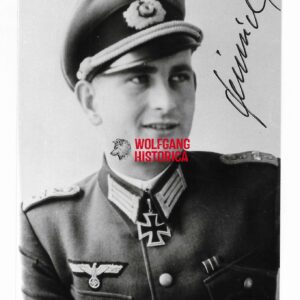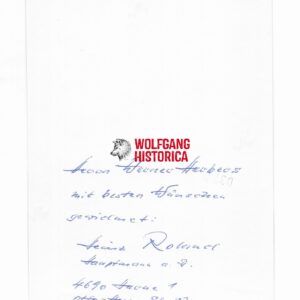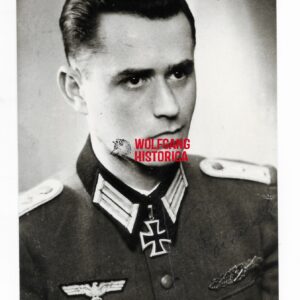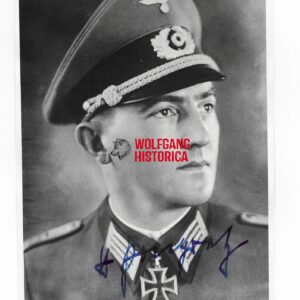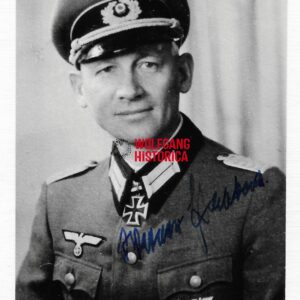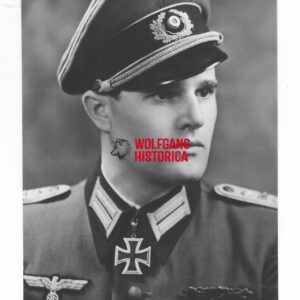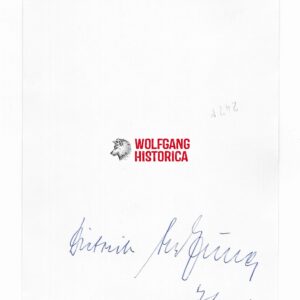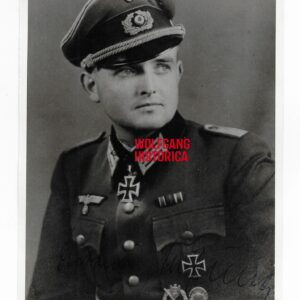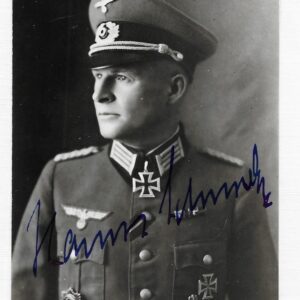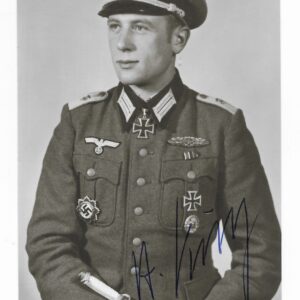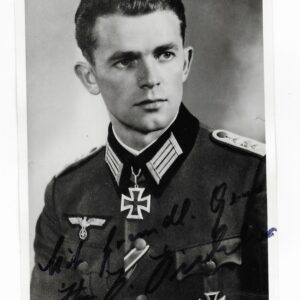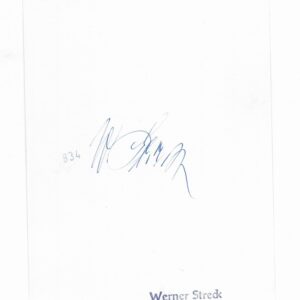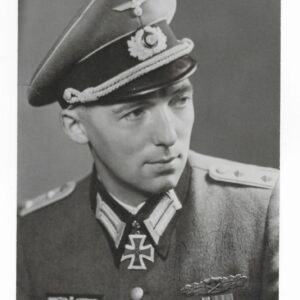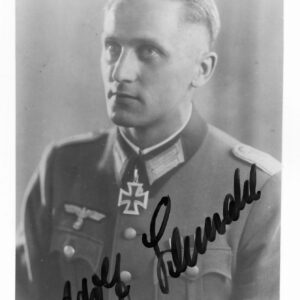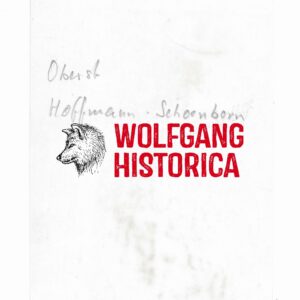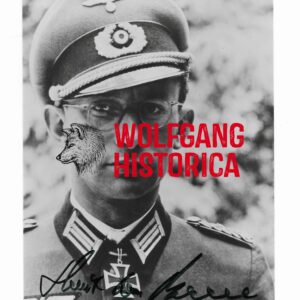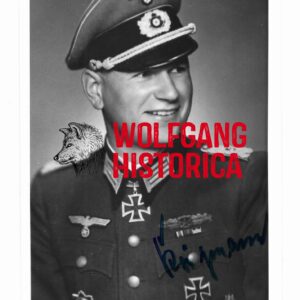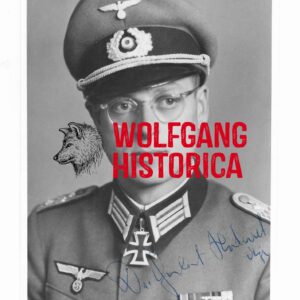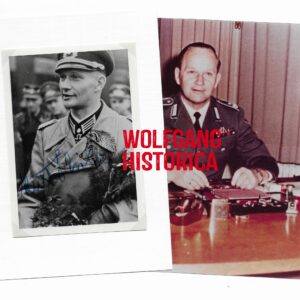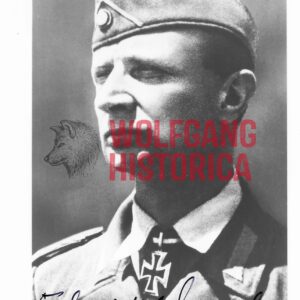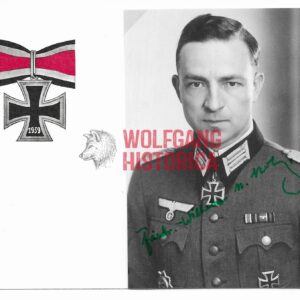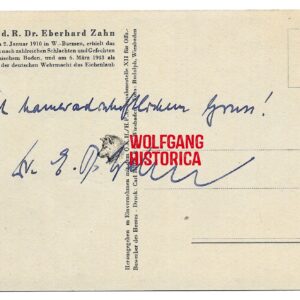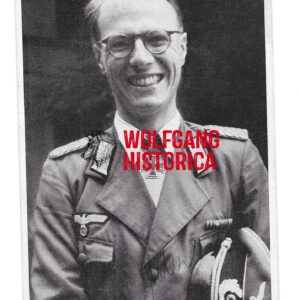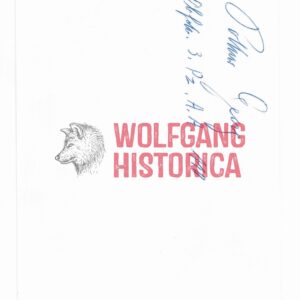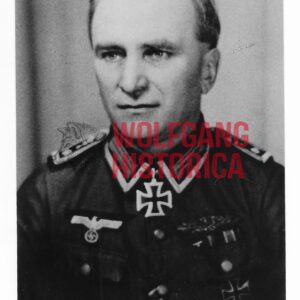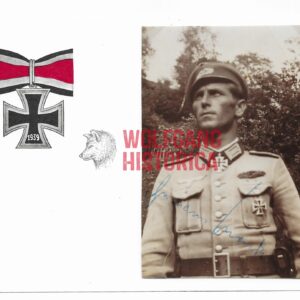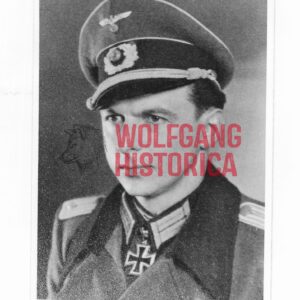Wilhelm Schütten – Panzergrenadier-Regiment 4 (6. Panzer-Division)
€20,00Original Postwar Signature on a Postwar Photo of Wilhelm "Willy" Schütten. Oberfeldwebel Wilhelm Schütten (20.11.1917 † 01.12.1986 in Dortmund) earned the Ritterkreuz des Eisernen Kreuzes on June 4, 1944 as Oberfeldwebel und Zugführer in the 3. Kompanie/ Panzergrenadier-Regiment 4 of the 6. Panzer-Division.
Provenance: This signature comes from one of the largest postwar signature collection I’ve ever commissioned. This collection was started by a Waffen-SS Veteran, Werner H., in the 1950’s until he passed away.
Wilhelm Schütten – Panzergrenadier-Regiment 4 (6. Panzer-Division)
€20,00Original Postwar Signature on a Postwar Photo of Wilhelm "Willy" Schütten. Oberfeldwebel Wilhelm Schütten (20.11.1917 † 01.12.1986 in Dortmund) earned the Ritterkreuz des Eisernen Kreuzes on June 4, 1944 as Oberfeldwebel und Zugführer in the 3. Kompanie/ Panzergrenadier-Regiment 4 of the 6. Panzer-Division.
Provenance: This signature comes from one of the largest postwar signature collection I’ve ever commissioned. This collection was started by a Waffen-SS Veteran, Werner H., in the 1950’s until he passed away.
Arthur Tiefensee – Grenadier-Regiment 43 (1. Infanterie-Division)
€20,00Original Postwar Signature on a Postwar Photo of Arthur Tiefensee. Leutnant Arthur Tiefensee (22.03.1911 in Königsberg † 17.04.2000 in Bremen) earned the Ritterkreuz des Eisernen Kreuzes on August 3, 1944 as Leutnant und Führer of the 7. Kompanie/ Grenadier-Regiment 43 of the 1. Infanterie-Division.
Provenance: This signature comes from one of the largest postwar signature collection I’ve ever commissioned. This collection was started by a Waffen-SS Veteran, Werner H., in the 1950’s until he passed away.
Heinz Pfitzner – Pionier-Bataillon 290 (290. Infanterie-Division)
€30,00Gerhard Pick – Grenadier-Regiment 490 & 577 (Eichenlaub)
€25,00Provenance: This signature comes from one of the largest postwar signature collection I’ve ever commissioned. This collection was started by a Waffen-SS Veteran, Werner H., in the 1950’s until he passed away.
Peter Veeser – Infanterie-Regiment 125
€25,00Günter Prill – Grenadier-Regiment 51 (18. Infanterie-Division)
Günter Prill – Grenadier-Regiment 51 (18. Infanterie-Division)
€25,00Hermann Schütz – Grenadier-Regiment 273 (93. Infanterie-Division)
€20,00Original Postwar Signature on a Postwar Photo of Hermann Schütz. Major Hermann Schütz (08.05.1914 in Weinheim † 11.11.1991 in Weinheim) earned the Ritterkreuz des Eisernen Kreuzes on April 21, 1944 as Hauptmann und Führer of the I. Bataillon/ Grenadier-Regiment 273 of the 93. Infanterie-Division.
Provenance: This signature comes from one of the largest postwar signature collection I’ve ever commissioned. This collection was started by a Waffen-SS Veteran, Werner H., in the 1950’s until he passed away.
Gerold Overhoff – Grenadier-Regiment 11 (14. Infanterie-Division)
€20,00Heino Freiherr von Weidenberg-Künsberg – Grenadier-Regiment 188 (68. Infanterie-Division)
€25,00Original Postwar Signature on a Postwar Photo of Heino Freiherr von Weidenberg-Künsberg. Oberstleutnant Heino Freiherr von Weidenberg-Künsberg (02.09.1905 in Speyer † 29.01.1984 in Ascona, Switzerland) earned the Ritterkreuz des Eisernen Kreuzes on September 16, 1943 as Oberstleutnant und Kommandeur of the Grenadier-Regiment 188 of the 68. Infanterie-Division.
Provenance: This signature comes from one of the largest postwar signature collection I’ve ever commissioned. This collection was started by a Waffen-SS Veteran, Werner H., in the 1950’s until he passed away.Wolf Recktenwald – Radfahr-Schwadron 255 (255. Infanterie-Division)
€20,00Original Postwar Signature on a Postwar Photo of Wolf Recktenwald. Hauptmann Wolf Recktenwald (12.08.1917 in Oldenburg † 15.03.2005 in Bonn) earned the Ritterkreuz des Eisernen Kreuzes on May 24, 1943 as Oberleutnant und Chef of the Radfahr-Schwadron 255 of the 255. Infanterie-Division.
Provenance: This signature comes from one of the largest postwar signature collection I’ve ever commissioned. This collection was started by a Waffen-SS Veteran, Werner H., in the 1950’s until he passed away.Helmut Sinning – Grenadier-Regiment 181 (52. Infanterie-Division)
€20,00Provenance: This signature comes from one of the largest postwar signature collection I’ve ever commissioned. This collection was started by a Waffen-SS Veteran, Werner H., in the 1950’s until he passed away.
Anton Ritter – Grenadier-Regiment 88 (15. Infanterie-Division)
€20,00Original Postwar Signature on a Postwar Photo of Anton Ritter. Oberleutnant Anton Ritter (14.12.1919 in Piel-Landshut † 20.01.2007 in Dachau) earned the Ritterkreuz des Eisernen Kreuzes on December 24, 1944 as Leutnant und Führer of the Grenadier-Regiment 88 of the 15. Infanterie-Division. Signed on the back, on the front is copied.
Provenance: This signature comes from one of the largest postwar signature collection I’ve ever commissioned. This collection was started by a Waffen-SS Veteran, Werner H., in the 1950’s until he passed away.
Siegfried Schmoll – Grenadier-Regiment 217 (57. Infanterie-Division)
€20,00Provenance: This signature comes from one of the largest postwar signature collection I’ve ever commissioned. This collection was started by a Waffen-SS Veteran, Werner H., in the 1950’s until he passed away.
Otfried Maydorn – Grenadier-Regiment 545 (389. Infanterie-Division)
€20,00Original Postwar Signature on a Postwar Photo of Otfried Maydorn. Oberst Otfried Maydorn (15.03.1898 † 24.11.1983) earned the Deutsches Kreuz in Gold on December 17, 1943 with Grenadier-Regiment 554 and the Ritterkreuz des Eisernen Kreuzes on December 12, 1944 as Oberst und Kommandeur of the Grenadier-Regiment 545 of the 389. Infanterie-Division.
Provenance: This signature comes from one of the largest postwar signature collection I’ve ever commissioned. This collection was started by a Waffen-SS Veteran, Werner H., in the 1950’s until he passed away.
Aloys Mocken – Grenadier-Regiment 216 (86. Infanterie-Division)
€20,00Original Postwar Signature on a Postwar Photo of Aloys Mocken. Hauptmann Aloys Mocken (13.04.1913 † 10.05.1998) earned the Deutsches Kreuz in Gold on February 28, 1942 with the 7. Kompanie/ Grenadier-Regiment 184 and the Ritterkreuz on July 28, 1943 Hauptmann und Kommandeur of the I. Bataillon/ Grenadier-Regiment 216 of the 86. Infanterie-Division.
Provenance: This signature comes from one of the largest postwar signature collection I’ve ever commissioned. This collection was started by a Waffen-SS Veteran, Werner H., in the 1950’s until he passed away.
Hermann Schmidt – Artillerie-Regiment 81 (97. Jäger-Division)
€20,00Original Postwar Signature on a Postwar Photo of Hermann Schmidt. Major im Generalstab Hermann Schmidt (13.05.1915 in Braunetsried-Vohenstrauß † 01.07.2002 in München) earned the Ritterkreuz des Eisernen Kreuzes on June 28, 1943 as Hauptmann und Kommandeur of the IV. Abteilung/ Artillerie-Regiment 81 of the 97. Jäger-Division.
Provenance: This signature comes from one of the largest postwar signature collection I’ve ever commissioned. This collection was started by a Waffen-SS Veteran, Werner H., in the 1950’s until he passed away.
Werner Kamischke – Grenadier-Regiment 4 (32. Infanterie-Division)
€25,00Original Postwar Signature (2x) on a Postwar Photo of Werner Kamischke. Hauptmann Werner Kamischke (16.06.1914 † 10.03.1999) earned the Deutsches Kreuz in Gold on February 11, 1943 with Grenadier-Regiment 507 and the Ritterkreuz on January 9, 1945 as Hauptmann und Kommandeur of II. Bataillon/ Grenadier-Regiment 4 of the 32. Infanterie-Division.
Provenance: This signature comes from one of the largest postwar signature collection I’ve ever commissioned. This collection was started by a Waffen-SS Veteran, Werner H., in the 1950’s until he passed away.
Werner Schröder – Grenadier-Regiment 1124 (558. Volks-Grenadier-Division)
€20,00Karl Thiel – Artillerie-Regiment 217 (217. Infanterie-Division)
€20,00Original Postwar Signature on a Postwar Photo of Karl Thiel. Wachtmeister Karl Thiel (23.12.1913 † 29.02.2004) earned the Ritterkreuz des Eisernen Kreuzes on August 8, 1944 as Unteroffizier und Geschutzführer of the 1. Batterie/ Artillerie-Regiment 217 of the 217. Infanterie-Division.
Provenance: This signature comes from one of the largest postwar signature collection I’ve ever commissioned. This collection was started by a Waffen-SS Veteran, Werner H., in the 1950’s until he passed away.
Hans von Poncet – Grenadier-Regiment 358 (205. Infanterie-Division)
€25,00Original Postwar Signature on a Postwar Photo of Hans von Poncet. Oberst Hans von Poncet (26.04.1899 † 27.11.1983) earned the Ritterkreuz des Eisernen Kreuzes on August 9, 1944 as Oberst und Kommandeur of the Grenadier-Regiment 358 of the 205. Infanterie-Division.
Provenance: This signature comes from one of the largest postwar signature collection I’ve ever commissioned. This collection was started by a Waffen-SS Veteran, Werner H., in the 1950’s until he passed away.
Herbert Heinrich – Artillerie-Regiment 267 (267. Infanterie-Division)
€20,00Original Postwar Signature on a Postwar Photo of Herbert Heinrich. Hauptmann Herbert Heinrich (24.09.1918 in Hamburg-Altona † 25.02.1993 in Düsseldorf) earned the Ritterkreuz des Eisernen Kreuzes on March 15, 1944 as Oberleutnant und Chef of the 3. Batterie/ Artillerie-Regiment 267 of the 267. Infanterie-Division.
Provenance: This signature comes from one of the largest postwar signature collection I’ve ever commissioned. This collection was started by a Waffen-SS Veteran, Werner H., in the 1950’s until he passed away.
Heinz Roland – Panzergrenadier-Regiment 73 (Born in Chicago, USA!)
€35,00Original Postwar Signature on a Postwar Photo of Heinz Roland. Hauptmann Heinz Roland (21.10.1913 in Chicago, USA (!) † 26.07.1985) earned the Ritterkreuz des Eisernen Kreuzes on December 9, 1944 as Hauptmann und Führer of the II. Bataillon/ Panzergrenadier-Regiment 73 of the 19. Panzer-Division.
Provenance: This signature comes from one of the largest postwar signature collection I’ve ever commissioned. This collection was started by a Waffen-SS Veteran, Werner H., in the 1950’s until he passed away.
Johann Pongratz – Infanterie-Regiment 74 (19. Panzer-Division)
€20,00Werner Pankow – Infanterie-Regiment 151 (61. Infanterie-Division)
€20,00Original Postwar Signature on a Postwar Photo of Werner Pankow. Hauptmann Dr. Werner Pankow (02.02.1897 † 06.09.1980) earned the Ritterkreuz des Eisernen Kreuzes on September 20, 1941 as Hauptmann d.R. und Führer of the II. Bataillon/ Infanterie-Regiment 151 of 61. Infanterie-Division. Good condition.
Provenance: This signature comes from one of the largest postwar signature collection I’ve ever commissioned. This collection was started by a Waffen-SS Veteran, Werner H., in the 1950’s until he passed away.
Matthias Roth – Grenadier-Regiment 105 (72. Infanterie-Division)
€20,00Original Postwar Signature on a Postwar Photo of Matthias Roth. Oberleutnant Matthias Roth (22.08.1917 † 11.04.1996) earned the Ritterkreuz des Eisernen Kreuzes on February 21, 1944 as Oberleutnant und Führer in the II. Bataillon/ Grenadier-Regiment 105 of the 72. Infanterie-Division.
Provenance: This signature comes from one of the largest postwar signature collection I’ve ever commissioned. This collection was started by a Waffen-SS Veteran, Werner H., in the 1950’s until he passed away.
Dietrich ter Jung – Panzergrenadier-Regiment 79 (16. Panzer-Division)
€20,00Original Postwar Signature on a Postwar Photo of Dietrich ter Jung. Oberleutnant Dietrich ter Jung (19.02.1916 in Duisburg † 22.11.2018) earned the Ritterkreuz des Eisernen Kreuzes on May 4, 1944 as Oberleutnant und Führer in the II. Bataillon/ Panzergrenadier-Regiment 79 of the 16. Panzer-Division.
Provenance: This signature comes from one of the largest postwar signature collection I’ve ever commissioned. This collection was started by a Waffen-SS Veteran, Werner H., in the 1950’s until he passed away.
Johannes Schmidt – Panzer-Regiment 27 (19. Panzer-Division)
€22,50Original Postwar Signature on a Postwar Photo of Dipl.-Ing. Johannes Schmidt. Dipl.-Ing. Johannes Schmidt (30.09.1899 † 10.11.1987) earned the Deutsches Kreuz in Gold and Ritterkreuz on October 15, 1942 as Oberstleutnant and Kommandeur of the III. Abteilung/ Panzer-Regiment 27 of the 19. Panzer-Division.
Provenance: This signature comes from one of the largest postwar signature collection I’ve ever commissioned. This collection was started by a Waffen-SS Veteran, Werner H., in the 1950’s until he passed away.
Hermann Kunz – Panzerjäger-Abteilung 37 (1. Panzer-Division)
€20,00Original Postwar Signature on a Postwar Photo of Hermann Kunz. Leutnant Hermann Kunz (12.12.1919 in Augsburg † 18.03.2012 in Augsburg) earned the Deutsches Kreuz in Gold on February 11, 1943 and the Ritterkreuz des Eisernen Kreuzes on December 17, 1943 as Leutnant und Zugführer in the 2. Kompanie/ Panzerjäger-Abteilung 37 of the 1. Panzer-Division.
Provenance: This signature comes from one of the largest postwar signature collection I’ve ever commissioned. This collection was started by a Waffen-SS Veteran, Werner H., in the 1950’s until he passed away.
Erich Eichler – Artillerie-Regiment 20 (20. Panzer-Grenadier-Division)
€20,00Original Postwar Signature on a Postwar Photo of Erich Eichler. Hauptmann Erich Eichler (19.08.1914 † 08.03.2003) earned the Ritterkreuz des Eisernen Kreuzes on September 21, 1944 as Hauptmann with the II. Abteilung/ Artillerie-Regiment 20 of the 20. Panzer-Grenadier-Division.
Provenance: This signature comes from one of the largest postwar signature collection I’ve ever commissioned. This collection was started by a Waffen-SS Veteran, Werner H., in the 1950’s until he passed away.
Werner Streck – Feld-Ersatz-Bataillon 81 (50. Infanterie-Division)
€20,00Original Postwar Signature on a Postwar Photo of Werner Streck. Hauptmann Werner Streck (04.11.1913 in Tschirma † 10.08.2002 in Bischofsheim) earned the Ritterkreuz des Eisernen Kreuzes on December 28, 1943 as Hauptmann und Führer of the Feld-Ersatz-Bataillon 81 of the 50. Infanterie-Division.
Provenance: This signature comes from one of the largest postwar signature collection I’ve ever commissioned. This collection was started by a Waffen-SS Veteran, Werner H., in the 1950’s until he passed away.
Adolf Schmahl – Infanterie-Regiment 6 (30. Infanterie-Division)
€20,00Original Postwar Signature on a Postwar Photo of Adolf Schmahl. Leutnant Adolf Schmahl (06.01.1916 in Brux † 14.03.2004) earned the Ritterkreuz des Eisernen Kreuzes on July 7, 1942 as Leutnant und Führer of the 10. Kompanie/ Infanterie-Regiment 6 of the 30. Infanterie-Division.
Provenance: This signature comes from one of the largest postwar signature collection I’ve ever commissioned. This collection was started by a Waffen-SS Veteran, Werner H., in the 1950’s until he passed away.
Klaus Müller – Panzer-Abteilung 60
€25,00Heinrich Benner – Panzer-Artillerie-Regiment 102 (9. Panzer-Division)
€35,00Heinz Kolczyk – Panzer-Aufklärungs-Abteilung 7 (7. Panzer-Division)
€20,00Original Postwar Signature on a Postwar Photo of Heinz Kolczyk. Rittmeister Heinz Kolczyk (20.11.1912 † 10.11.2008) earned the Ritterkreuz des Eisernen Kreuzes on April 6, 1944 as Rittmeister und Kommandeur of the Panzer-Aufklärungs-Abteilung 7 of the 7. Panzer-Division. Good condition. Size: 8×11,3cm.
Provenance: This signature comes from one of the largest postwar signature collection I’ve ever commissioned. This collection was started by a Waffen-SS Veteran, Werner H., in the 1950’s until he passed away.
Konrad Zeller – Grenadier-Regiment 380 (215. Infanterie-Division)
€25,00Original Postwar Signature on a Postwar Photo of Konrad Zeller. Hauptmann Konrad Zeller (09.09.1911 † 24.01.1996) earned the Ritterkreuz on January 5, 1944 as Hauptmann und Kommandeur of the I. Bataillon/ Grenadier-Regiment 380 and the Eichenlaub on June 9, 1944 as Hauptmann und Kommandeur of the III. Bataillon/ Grenadier-Regiment 380 of the 215. Infanterie-Division.
Provenance: This signature comes from one of the largest postwar signature collection I’ve ever commissioned. This collection was started by a Waffen-SS Veteran, Werner H., in the 1950’s until he passed away.
Günther Hoffmann-Schönborn – Sturmgeschütz-Abteilung 191 (EL) (Wartime Signed)
€165,00Heinz von Brese – Panzer-Grenadier-Regiment 108 (Eichenlaub)
€25,00Original Postwar Signature on a Postwar Photo of Heinz von Brese. Major Heinz von Brese-Winiary (13.01.1914 † 03.12.1995) earned the Deutsches Kreuz in Gold on December 24, 1941 as Oberleutnant with the Infanterie-Regiment 10, the Ritterkreuz on May 15, 1943 as Major und Führer of II. Bataillon/ Panzer-Grenadier-Regiment 108 of the 14. Panzer-Division and the Eichenlaub on April 6, 1944 as Major und Führer of II. Bataillon/ Panzer-Grenadier-Regiment 108 of the 14. Panzer-Division. Good condition.
Provenance: This signature comes from one of the largest postwar signature collection I’ve ever commissioned. This collection was started by a Waffen-SS Veteran, Werner H., in the 1950’s until he passed away.
Friedrich-Karl Krützmann – Panzergrenadier-Regiment 5 (12. Panzer-Division)
€20,00Original Postwar Signature on a Postwar Photo of Friedrich-Karl Krützmann. Hauptmann Friedrich-Karl Krützmann (19.05.1917 in Greifenberg † 16.05.2004 in Ahrensburg) earned the Deutsches Kreuz in Gold on November 28, 1942 and the Ritterkreuz des Eisernen Kreuzes on March 3, 1944 as Hauptmann und Kommandeur in the 3. Kompanie/ Panzergrenadier-Regiment 5 of the 12. Panzer-Division.
Provenance: This signature comes from one of the largest postwar signature collection I’ve ever commissioned. This collection was started by a Waffen-SS Veteran, Werner H., in the 1950’s until he passed away.
Herbert Hodurek – Gebirgsjäger-Regiment 144 (3. Gebirgs-Division)
€25,00Original Postwar Signature on a Postwar Photo of Herbert Hodurek. Major Herbert Hodurek (10.02.1915 in Salzburg † 04.07.2003 in Salzburg) earned the Ritterkreuz des Eisernen Kreuzes on April 15, 1944 as Hauptmann und Führer of the III. Bataillon/ Gebirgsjäger-Regiment 144 of the 3. Gebirgs-Division.
Provenance: This signature comes from one of the largest postwar signature collection I’ve ever commissioned. This collection was started by a Waffen-SS Veteran, Werner H., in the 1950’s until he passed away.
Curt Schille – Pionier-Bataillon 24 (Eichenlaub)
€27,50Original Postwar Signature on a Postwar Photo of Curt Schille. Major Curt Schille (28.11.1910 † 19.12.1985) earned the Ritterkreuz on August 25, 1942 as Hauptmann und Chef of the 3. Kompanie/ Pionier-Bataillon 24 and the Eichenlaub on August 8, 1944 as Major und Kommandeur of the Pionier-Bataillon 24 of the 24. Infanterie-Division. Good condition.
Provenance: This signature comes from one of the largest postwar signature collection I’ve ever commissioned. This collection was started by a Waffen-SS Veteran, Werner H., in the 1950’s until he passed away.
Friedrich-Wilhelm Musculus – Panzerjäger-Abteilung 111
€22,50Friedrich-Wilhelm von Notz – Grenadier-(Führernachwuchs-)Regiment 1233 (Oder – Seelow)
€25,00Dr. Eberhard Zahn – Panzerjäger-Abteilung 33 (Eichenlaub)
€35,00Original Postwar Signature on a Original Wartime Postcard of Dr. Eberhard Zahn. Oberstleutnant Dr. Eberhard Zahn (02.01.1910 † 07.02.2010) earned the Ritterkreuz on June 30, 1941 as Leutnant und Zugführer of the 2. Kompanie/ Panzerjäger-Abteilung 33 and the Eichenlaub on March 6, 1943 as Hauptmann und Kompaniechef of the 2. Kompanie/ Panzerjäger-Abteilung 33 of the 15. Panzer-Division.
Provenance: This signature comes from one of the largest postwar signature collection I’ve ever commissioned. This collection was started by a Waffen-SS Veteran, Werner H., in the 1950’s until he passed away.
Georg Pollner – Panzer-Aufklärungs-Abteilung 110
€20,00Provenance: This signature comes from one of the largest postwar signature collection I’ve ever commissioned. This collection was started by a Waffen-SS Veteran, Werner H., in the 1950’s until he passed away.
Hermann Wonde – Kavallerie-Regiment 41 (4. Kavallerie-Division)
€25,00Original Postwar Signature on a Postwar Photo of Hermann Wonde. Leutnant Hermann Wonde (25.03.1915 † 27.01.1987) earned the Ritterkreuz des Eisernen Kreuzes on March 23, 1945 as Leutnant und Führer of the 6. Schwadron/ Kavallerie-Regiment 41 of the 4. Kavallerie-Division. Attached with photo corners on a PC card.
Provenance: This signature comes from one of the largest postwar signature collection I’ve ever commissioned. This collection was started by a Waffen-SS Veteran, Werner H., in the 1950’s until he passed away.
Adolf Vogt – Grenadier-Regiment 1054 (85. Infanterie-Division)
€25,00Original Postwar Signature on a Postwar Photo of Adolf Vogt. Oberleutnant Adolf Vogt (31.08.1915 † 21.09.1992) earned the Ritterkreuz des Eisernen Kreuzes on October 16, 1944 as Oberleutnant und Chef of the 12. Kompanie/ Grenadier-Regiment 1054 of the 85. Infanterie-Division.
Provenance: This signature comes from one of the largest postwar signature collection I’ve ever commissioned. This collection was started by a Waffen-SS Veteran, Werner H., in the 1950’s until he passed away.


